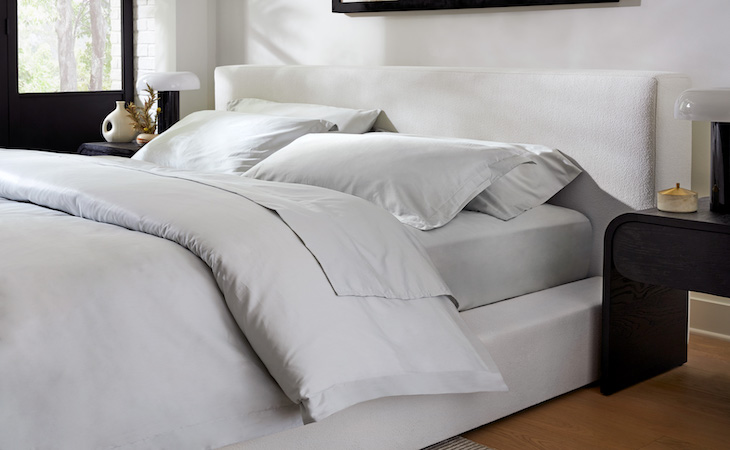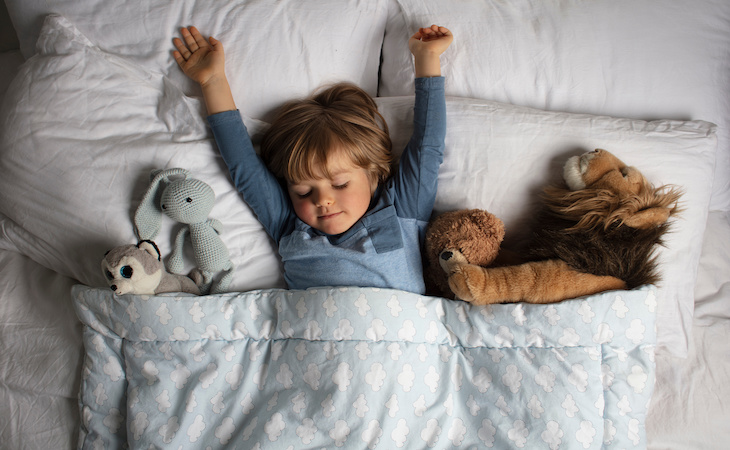
Choosing the right kids’ bedding involves prioritizing safety, comfort, breathability, and hypoallergenic materials like cotton, bamboo, or linen. Look for durable, easy-care fabrics with third-party certifications. Fun, age-appropriate designs can encourage better sleep. Bedding should be washed weekly, and allergy-prone kids benefit from natural, moisture-wicking materials that reduce allergens and irritation.
As a parent, you want to ensure that your child has a good night’s sleep every night. Choosing the right mattress for them is important, but it isn’t the only decision you’ll need to make. Just like for adults, kids’ bedding can also make a huge difference in the quality of their sleep.
However, as with everything, not all kids’ bedding is created equally. Here’s what you need to know when choosing the best kids’ bedding for your child.

Factors to consider when choosing kids’ bedding
The most important factors when choosing the right bedding for your child are safety and comfort. Ideally, the bedding should also be something your child loves and that may last them a long time.
Comfort and softness
Children’s bedding should be soft and comfortable. Quality cotton, bamboo, jersey, and flannel (for warmer months) are all excellent options.
Linen can feel rougher than other fabrics, which might be a problem for kids with sensitive skin, but it gets softer with every wash. If you go with linen, choose sheets that come pre-washed for extra softness from the beginning.
In addition to the type of material, look at fiber length: Longer fibers tend to produce a smoother and softer fabric.
Breathability and temperature regulation
You’ll want to make sure the sheets are breathable and don’t trap moisture so your child doesn’t get too hot. Good options include natural fibers such as cotton, bamboo, and linen.
On the other hand, if you’re looking for sheets that will keep your child warm and cozy in the winter, consider sheets that retain heat without making your child sweat, such as flannel or fleece.
Hypoallergenic materials
Consider getting a set made of hypoallergenic material.
Linen is naturally hypoallergenic because it has unique filtering properties that greatly reduce the number of allergens and germs typically found in bed sheets.
Bamboo is also a great choice because it’s naturally breathable and has excellent moisture-wicking properties, helping reduce the chance of mold growth and the spread of dust mites.
Cotton is another great option because of its breathability. Make sure to get 100% cotton as many sheets that are marketed as cotton are synthetic blends that will trap moisture and might irritate your child’s skin.
Long-staple cotton is more breathable than short-staple cotton. Additionally, if you can find cotton sheets that are undyed or made with environmentally-friendly dyes, that would be even better for your child’s skin.
Quality microfiber might be a good choice as its tight weave pattern can help reduce the number of allergens. Avoid any brushed microfiber sheets as their fuzzy texture is more likely to trap allergens.
Third party certifications
Look for third-party certifications on bedding that state the materials are free of harmful chemicals to ensure health and safety.
You may want to consider getting a set of organic sheets as they’re an environmentally conscious option and can be better your child’s health since they’re typically free from pesticides and other harmful chemicals.
Design and theme
Don’t underestimate the appearance of the bedding. Yes, safety and quality materials are paramount, but looks have the power to make or break bedtime.
Get superhero-themed bedding for a comic fan and you’ll have a child who looks forward to bedtime every night.
If you want it to be something that can grow up with them, choose something more general, like their favorite color, rather than a specific character that they might fall out of love with next week.
For an ultimate personal touch, consider getting monogrammed bedding with your child’s name or initials embroidered in their favorite color.
Whatever you choose, try to make sure that the patterns, colors, and overall theme of the bedding add to a sleeping environment that your child will feel at home in.
Durability and easy maintenance
Your child’s bedding will have to be washed frequently, so make sure to choose durable fabrics that can withstand multiple washes.
Quality cotton, bamboo, or linen sheets should last you for many years. Long-staple cotton is more durable than cotton made from shorter fibers. Linen is not only extremely durable but also softens with each wash.
Types of kids’ bedding
Kids’ bedding includes all the things adults’ bedding does. You’ll want to choose a bottom layer and a pillowcase, plus one or more of the many available options for a top layer of bedding.
Sheets and pillowcases
Sheets and pillowcases are the most basic components of kids’ bedding. You want to have a couple of those as they’ll be in closest contact with your child’s skin and will need to be washed most often.
Comforters and duvet covers
Next, you’ll want to choose the top layer: a duvet or a comforter. The decision between the two is a matter of personal choice.
Both are essentially big fabric bags filled with down or down alternative filling. The difference is that a duvet is white and has to be used with a duvet cover, while a comforter is patterned and is typically used with a top sheet.
Quilts and coverlets
A quilt is a lighter type of top layer that’s maybe suitable for warmer months. Keep in mind that some quilts can’t be washed in the washing machine.
A coverlet, unlike a quilt, is made with a single piece of fabric.
Blankets and throws
A blanket (also called a throw blanket) is a top layer that’s made of a single sheet of fabric, such as fleece, flannel, wool, or polyester.
A throw blanket can be used on its own or in combination with another type of top layer for added warmth.
What’s the best material for a kids’ blanket? As with everything kids’ bedding, ideally it should be something that can be thrown into the washing machine.
Tips for maintaining kids’ bedding
Washing and care instructions
Just like adults’ bedding, kids’ bedding should be washed regularly—usually every week or every two weeks.
Washing less frequently can lead to the accumulation of dust and allergens, which may cause allergic reactions and other health issues.
Many manufacturers recommend washing the sheets in cool water, but if your child has been sick, you might want to wash the bedding at a hotter temperature.
Stain removal tips
Stains are going to be unavoidable with kids’ bedding.
Whether it’s your 8-year-old coloring in bed and leaving crayon marks on the sheets, a teenager spilling some orange juice onto the pillow, or a younger child having an accident, expect stains and don’t panic.
Different stains require slightly different approaches, but the vast majority of them can be removed with the right ingredients.
FAQs
What materials are best for kids’ bedding in terms of comfort and safety?
For kids’ bedding, you want to choose soft, comfortable, and hypoallergenic fabrics with good temperature regulation. Natural materials such as bamboo, 100% cotton, or linen are all great options. If you can, get sheets made from organic fabric or sheets that are undyed or made with environmentally-conscious dyes.
How often should I wash my child’s bedding?
Similar to adult bedding, children’s bedding should be washed regularly—preferably every week or every two weeks. Washing less often can result in the buildup of dust and allergens, potentially leading to allergic reactions and other health problems.
What size bedding should I buy for a toddler versus an older child?
When choosing bedding for a toddler versus an older child, it’s important to consider the bed size. If your toddler sleeps in a toddler bed, you should purchase bedding that fits this specific size.
A toddler bed mattress is typically the same size as a standard crib mattress (28″ x 52”). For an older child who’s transitioned to a regular twin-size bed, you should select bedding that corresponds to the twin mattress dimensions.
Are there specific bedding types recommended for children with allergies?
If your child is prone to allergies, choose fabrics that are naturally hypoallergenic. Linen, bamboo, and 100% cotton are all good choices.
Bamboo and cotton are naturally breathable and moisture-wicking, reducing mold and dust mites. Linen has unique filtering properties that allow it to greatly reduce the number of allergens.
Quality microfiber with a tight weave is another good option, but avoid brushed microfiber sheets, as their fuzzy texture traps more allergens.
How can I choose bedding that my child will love and that will fit their bedroom decor?
To choose bedding your child will love, consider getting a set featuring their favorite colors, themes, or characters. Then make sure the set complements the bedroom decor by coordinating with existing colors and patterns and creating a harmonious and inviting space.
Shelby Deering
Shelby Deering is a Madison, Wisconsin-based freelance lifestyle writer contributing home design and health articles to national publications. When she’s not writing, you’ll find her hiking, running, or walking with her husband and corgi, Dolly.





